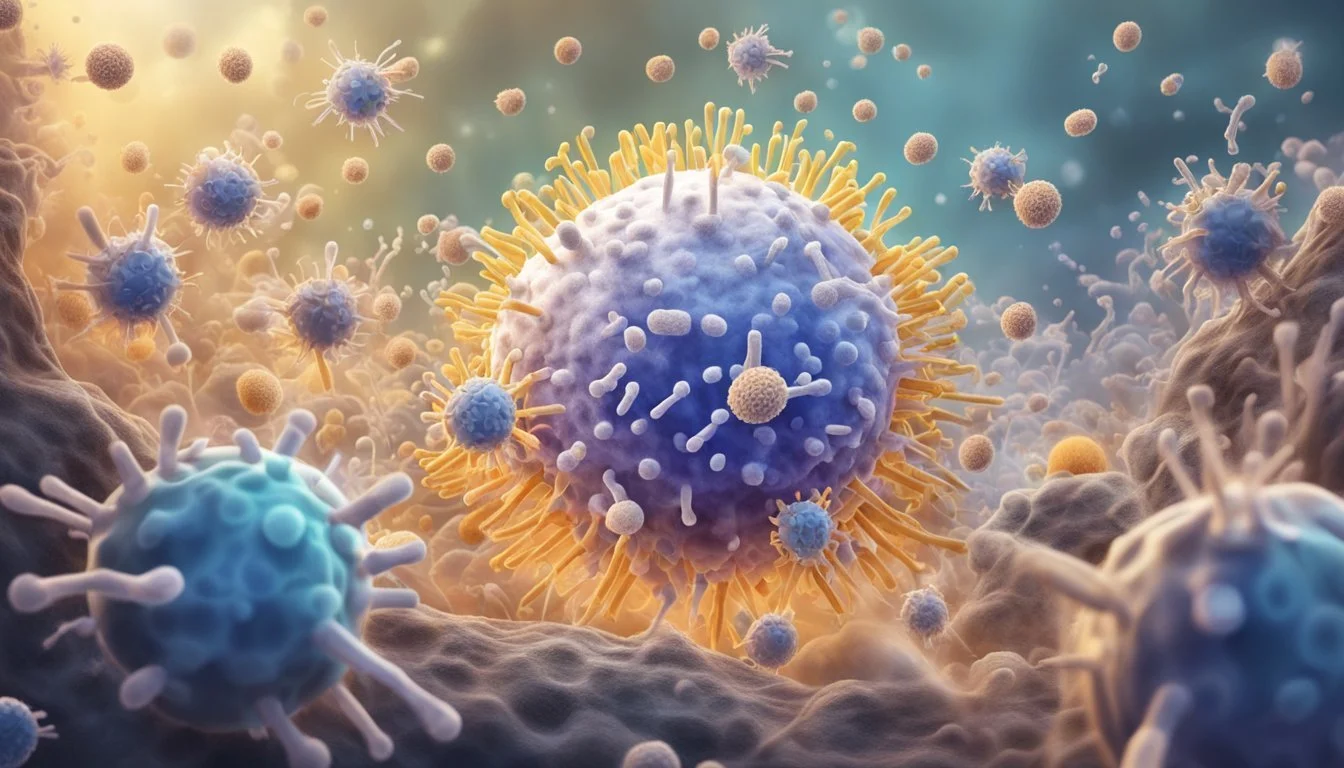FC-Cidal
The Carnivore's Guide to Fighting Infections Naturally and Effectively
For those exploring natural infection treatments, FC-Cidal presents a compelling option rooted in herbal wisdom. Combining a proprietary blend of herbs and extracts, FC-Cidal stands out by supporting healthy gastrointestinal function and promoting a balanced microbial environment.
The supplement includes potent ingredients like French tarragon (Artemisia dracunculus), which have long been valued for their antimicrobial properties. This makes FC-Cidal a practical choice for individuals prioritizing natural health solutions, particularly those following a carnivore diet who need to maintain optimal gut health.
Leveraging traditional culinary herbs, FC-Cidal targets harmful bacteria and supports overall digestive health. Whether dealing with issues like SIBO (Small Intestinal Bacterial Overgrowth) or seeking to maintain a healthy microbial balance, FC-Cidal emerges as a scientifically-backed alternative. This natural supplement harnesses the power of nature to aid in combating infections effectively.
The Rise of Antibiotic Resistance
Antibiotic resistance is a significant health issue globally. Factors such as bacterial evolution and the ease of global travel contribute to the spread of resistant strains, posing challenges for modern medicine.
Understanding Antibiotic Resistance
Antibiotic resistance occurs when bacteria adapt to the presence of antibiotics, rendering treatments less effective. This adaptation usually results from genetic mutations or the acquisition of resistance genes via horizontal gene transfer.
Examples of resistant bacteria include:
MRSA (Methicillin-resistant Staphylococcus aureus)
VRE (Vancomycin-resistant Enterococci)
By bypassing the mechanisms targeted by antibiotics, these bacteria can survive and proliferate, making infections harder to treat. Misuse and overuse of antibiotics in both healthcare and agriculture accelerate this process, leading to more widespread and dangerous resistant strains.
The Impact of Evolution on Antibiotic Resistance
Bacterial evolution plays a crucial role in the development of resistance. Natural selection favors bacteria that can survive antibiotic treatment, leading to an increase in resistant populations.
Bacteria reproduce rapidly, sometimes doubling in number every 20 minutes. This high replication rate means mutations conferring resistance can spread quickly through a population. Additionally, bacteria can share resistance genes through plasmids, enhancing their evolutionary adaptability.
Key factors in bacterial evolution:
Rapid reproduction
Genetic mutations
Horizontal gene transfer
These evolutionary mechanisms enable bacteria to adapt swiftly, outpacing the development of new antibiotics and posing a continuous threat to effective treatments.
Globalization and the Spread of Resistant Strains
Globalization significantly impacts the distribution of antibiotic-resistant bacteria. Increased travel and trade allow resistant strains to move quickly across borders, complicating efforts to control their spread. For example, a resistant strain emerging in one country can easily appear in another, far removed, within days.
International trade in livestock, where antibiotic use is rampant, further exacerbates the problem. The global food supply chain enables resistant bacteria to proliferate and spread through food products.
Contributing factors to the spread:
International travel
Global trade
Food supply chains
As a result, fighting antibiotic resistance requires coordinated global strategies to monitor and mitigate the spread of resistant strains.
The Carnivorous Diet and Immunity
The carnivorous diet, rich in animal-based foods, influences immunity through diverse mechanisms. These include the nutritional profile of meats and the innate immune responses of different animals, like cattle and sheep. Additionally, the dietary habits of predators are also considered in relation to parasitic infections.
Nutritional Profiles and Immune Response
Animal-based foods are packed with nutrients that play crucial roles in maintaining a robust immune system. Protein is essential for the production of antibodies and other immune cells. Zinc, found abundantly in red meat, supports immune cell function and communication.
Omega-3 fatty acids, present in fish and some meats, have anti-inflammatory properties that help regulate the immune response. Vitamin B12, found in animal products, is vital for maintaining a healthy nervous system and producing DNA and red blood cells, which in turn support immunity.
Ruminants: Cattle and Sheep Immunity
Ruminants like cattle and sheep have unique immune systems influenced by their diets, consisting primarily of grass and other plant materials. These animals possess a complex digestive system that includes the rumen, which aids in breaking down food and absorbing nutrients essential for immune function.
Immunoglobulins present in the colostrum of ruminants provide passive immunity to newborns, protecting them from infections. The natural microbiota in their gut also plays a role in immune response, helping to fend off pathogens and parasites.
Predation, Diet, and Parasitic Infections
Predators, including carnivorous mammals and birds, have immune systems adapted to their specific diets and hunting lifestyles. Their diets, mainly consisting of meat, expose them to a variety of parasites and pathogens.
Many predators have evolved robust immune responses to combat parasitic infections. Natural compounds in their diet, such as taurine found in meat, have been shown to support immune health. Regular intake of fresh, uncontaminated meat helps minimize parasitic load.
In summary, the carnivorous diet, whether in humans or animals, provides essential nutrients that can fortify the immune system. The specific dietary habits of ruminants and predators offer insights into how a meat-centric diet affects immunity and helps in fighting infections naturally.
Understanding Parasitic Diseases
Parasitic diseases affect a wide range of hosts, influencing behavior and health. These diseases are caused by various parasites with complex life cycles and may be managed through natural treatments.
Taxonomy of Common Parasites
Parasites are classified into several major groups including helminths, protozoa, ectoparasites, and others. Helminths, such as tapeworms and roundworms, are multicellular organisms. Protozoa, like Toxoplasma gondii, are single-celled and often intracellular. Ectoparasites include fleas and ticks, which attach to the host’s exterior.
Each of these groups contains species that infect carnivores, impacting their overall well-being. Understanding the genetic and biological diversity within these groups is crucial for effective parasitology and developing targeted treatments.
Parasitic Life Cycles and Host Behavior
Parasites have complex life cycles often involving multiple hosts and stages. For example, T. gondii can infect cougars, causing them to become intermediate hosts. Infected hosts may exhibit altered behaviors that facilitate the spread of the parasite.
Adult carnivores can inadvertently reduce transmission by frequently visiting den sites and eliminating infective stages. Behavioral patterns and interactions between hosts and parasites are critical for understanding and managing these infections.
Natural Approaches towards Parasitic Treatment
Natural treatment approaches focus on supporting the host’s immune system and maintaining a balanced gut microbiome. Products like FC-Cidal™ use herbal extracts to promote gastrointestinal health.
Culinary herbs have been historically used for antimicrobial properties, targeting both parasites and secondary infections. Utilization of these natural treatments requires careful consideration of dosage and combinations to avoid adverse effects and enhance efficacy against parasitic diseases.
Effective natural treatments should be integrated into broader management programs to control parasitic infections in carnivores. Using natural products can be a sustainable alternative to pharmaceutical treatments, potentially reducing the emergence of drug-resistant parasites.
Infection Detection and Diagnosis
Effective diagnosis of infections requires precise tools and methods. Accurate detection guides appropriate treatment, and advanced techniques ensure reliable results.
Diagnostic Tools and Techniques
Diagnosis starts with a thorough clinical evaluation.
Physical examination and patient history are crucial first steps.
Doctors may use various diagnostic tools, including:
Blood tests to detect antibodies or antigens.
Imaging techniques such as X-rays or MRIs.
Stool and urine samples for microbiological cultures.
These techniques help identify types of pathogens involved and assess the severity of the infection. While traditional methods are still vital, modern approaches like molecular diagnostics enhance accuracy and speed.
Polymerase Chain Reaction in Diagnosis
Polymerase Chain Reaction (PCR) is a powerful tool in detecting infections.
It amplifies DNA sequences, making it easier to identify pathogens in small samples. PCR’s sensitivity is high, allowing it to detect even minute amounts of pathogenic DNA.
Applications include:
Early detection of bacterial, viral, and fungal infections.
Specificity in identifying particular strains of pathogens.
Speed in producing results compared to culture methods.
PCR's role is pivotal in diagnosing infections quickly and accurately, particularly in critical situations.
Identifying Biomarkers for Parasitic Diseases
Biomarkers are critical for diagnosing parasitic diseases.
They provide specific indicators of disease presence. Common biomarkers include:
Proteins produced in response to infections.
Genomic markers unique to parasites.
Metabolites indicating parasitic activity.
Techniques like ELISA (enzyme-linked immunosorbent assay) detect these biomarkers. Biomarker identification aids in:
Early diagnosis and monitoring of disease progression.
Differentiating between types of parasitic infections.
Guiding on treatment efficacy and patient response.
Identifying precise biomarkers simplifies diagnosis and enhances treatment specificity for parasitic diseases.
Natural Treatment Strategies
Natural treatment strategies for fighting infections in carnivores involve the utilization of herbal medicines, dietary considerations, and alternative therapies. These methods aim to support immune function and microbial balance without relying solely on synthetic drugs.
Utilizing Herbal Medicines
Herbal medicines offer natural compounds that can combat infections effectively. FC-Cidal, for instance, contains a blend of seven herbs that promote healthy gastrointestinal function and microbial balance. Ingredients like French tarragon and emulsified oil of oregano provide antimicrobial properties that help control bacterial growth.
Dosage and administration are crucial for effectiveness. Typically, two capsules of FC-Cidal are recommended twice a day. These herbs are well-tolerated and provide a holistic approach to maintaining a healthy gut in carnivores.
Role of Diet in Treatment and Prevention
Diet plays a significant role in both treating and preventing infections in carnivores. A diet rich in high-quality protein supports overall immune function. Raw or minimally processed foods provide essential nutrients without the addition of artificial preservatives or antibiotics, which can disrupt gut health.
Prebiotics and probiotics enhance the gut microbiome by providing beneficial bacteria and the necessary substrate for their growth. Foods such as lean meats, organ meats, and bone broth ensure a balanced diet that supports microbial diversity and resistance to infections.
Alternative Therapies in Veterinary Care
Alternative therapies in veterinary care include practices like acupuncture, chiropractic adjustments, and homeopathy. These approaches are valuable for enhancing overall health and addressing specific conditions without contributing to antibiotic resistance.
A.D.P.®, a sustained-release formula of emulsified oil of oregano, is one such alternative treatment enhancing microbial balance. Incorporating these therapies supports the natural healing processes and can be used alongside conventional treatments for a more comprehensive healthcare strategy.
The combination of herbal medicines, appropriate diet, and alternative therapies provides an effective strategy to naturally combat infections and promote optimal health in carnivorous animals.
Vector-Borne Infections
Vector-borne infections are transmitted by various vectors such as insects and rodents. These infections pose significant threats to both human and animal health, particularly in regions with optimal environmental conditions for vectors.
Tsetse Fly and Trypanosoma Brucei
Trypanosoma brucei is a parasitic protozoan transmitted by the bite of the tsetse fly. This parasite is responsible for African trypanosomiasis, or sleeping sickness, affecting humans and animals. The tsetse fly thrives in tropical environments, making certain African regions endemic zones.
The disease manifests in two stages: the early stage with fever, headaches, and joint pains, and the late stage with neurological complications. Effective control of tsetse fly populations and monitoring animal reservoirs are essential strategies. Treatment of infected individuals with specific medications is necessary to combat the infection.
Zoonoses and the Role of Rodents
Rodents, including rats and mice, play a crucial role in zoonotic infections, diseases that can be transmitted from animals to humans. Many vector-borne diseases, such as hantavirus and leptospirosis, involve rodents either as primary hosts or through contamination of water and food with their excreta.
Rodents can carry fleas and ticks, which can further spread pathogens. Effective rodent control measures, maintaining hygiene, and minimizing human-rodent contact are critical. Public health initiatives must focus on educating communities about the risks associated with rodent-borne zoonoses and encourage preventive practices.
Transmission Dynamics and Control
Transmission dynamics of vector-borne diseases depend on complex interactions between vectors, hosts, and environmental factors. Climate change significantly influences these dynamics by altering vector habitats and lifespan, potentially increasing disease spread.
Key control measures include vector control programs such as insecticide spraying, use of bed nets, and public awareness campaigns. Looking at specific case studies, such as those from the CDC's "Fight the Bite" campaign, helps illustrate successful strategies. Research into the biology of vectors, environmental management, and development of vaccines and treatments remains essential for controlling vector-borne diseases.
Immunological Responses to Infections
The immune system relies on both innate and adaptive components to combat infections effectively. Critical factors such as cytokine expression and inflammatory responses play significant roles in defending against pathogens.
Innate vs. Adaptive Immune Systems
The innate immune system serves as the body's first line of defense. It includes physical barriers like skin and mucous membranes and internal defenses such as phagocytic cells, natural killer cells, and complement proteins. These components act quickly but non-specifically against a broad range of pathogens.
In contrast, the adaptive immune system is highly specific and has a memory component. It involves T cells and B cells, which recognize and remember specific antigens. Upon encountering the same pathogen again, the adaptive system responds more efficiently and robustly.
Cytokines and Inflammatory Responses
Cytokines are signaling molecules produced by immune cells to regulate the immune response. When an infection occurs, cytokine expression increases, leading to the recruitment and activation of other immune cells.
Inflammation is a critical aspect of the immune response initiated by cytokines. It features redness, heat, swelling, and pain, which serve to isolate pathogens and facilitate tissue repair. Dysregulated inflammation, however, can lead to tissue damage and chronic diseases. Proper balance in cytokine levels is essential for effective immune defense without causing harm to host tissues.
Environmental and Animal Behavior
Disease transmission in wildlife is influenced by environmental factors and animal behavior. Understanding these dynamics is crucial for managing and preventing infections.
The Ecology of Disease Transmission
The environment plays a critical role in how diseases spread among wildlife. Temperature, humidity, and vegetation can affect pathogen survival rates.
For instance, dense forests may harbor more ticks, increasing Lyme disease risk in deer. Water sources can become breeding grounds for parasites, impacting aquatic life.
Environmental changes, such as habitat destruction, can force animals into closer contact, raising disease transmission rates. Monitoring these factors helps predict and control outbreaks.
Animal Behavior and Disease Prevention
Animal behavior significantly influences disease dynamics. Social animals, like wolves, share close contact, which can facilitate the spread of infections like rabies.
Conversely, solitary predators may avoid disease through reduced interaction. Animals also develop behaviors to prevent disease, such as grooming and selective foraging.
Migratory patterns can help or hinder disease spread. Birds traveling long distances may introduce new pathogens to distant locations, complicating disease management.
Human Impacts on Wildlife Diseases
Human activities have profound effects on wildlife disease dynamics. Habitat destruction limits the space animals have, forcing them into smaller, more concentrated areas, increasing disease transmission.
Agricultural practices can bring wildlife into contact with domestic animals, creating new pathways for disease. Pollution and climate change alter ecosystems, making them more conducive to certain pathogens.
Efforts in conservation and habitat restoration can mitigate these impacts, illustrating the interconnectedness of human behavior and wildlife health. Understanding these relationships is vital for developing effective disease prevention strategies.
Case Studies and Outbreaks
This section covers how FC-Cidal can aid in responding to livestock disease outbreaks, the epidemiology of vector-borne diseases such as West Nile Virus, and insights gathered from historical pandemics.
Handling Disease Outbreaks in Livestock
FC-Cidal could be integral in managing disease outbreaks among livestock. Herds often face threats from pathogens, including bacteria and parasites like Trypanosoma brucei rhodesiense. Herb-based solutions like FC-Cidal, notable for its antimicrobial properties, can be administered to support the health of the animals.
Farmers utilize these botanical supplements to mitigate risks of infection and promote faster recovery. This not only helps in maintaining the animals' health but also ensures the stability of food production systems.
Epidemiology of Vector-Borne Diseases
Vector-borne diseases such as West Nile Virus are significant concerns in both human and animal populations. FC-Cidal's herbal components can offer supplementary support. While traditional methods focus on vector control, the antimicrobial properties of FC-Cidal potentially enhance resistance to infections post-exposure.
Understanding the spread patterns and seasonal outbreaks of diseases like West Nile Virus helps in the strategic deployment of FC-Cidal. Surveillance data and studies reveal infection hotspots, guiding targeted interventions.
Learning from Historical Pandemics
Studying historical pandemics provides valuable lessons for modern health crises. Botanical extracts similar to those found in FC-Cidal have historically been used to combat infections. For instance, during the Plague of Antonine, various herbal remedies were documented for their efficacy in reducing symptoms.
By examining mortality rates, response strategies, and recovery periods, researchers can better understand how herbal supplements might play a role in contemporary infection control. Integrating these historical practices with modern science offers a comprehensive approach for managing disease outbreaks.
Cultural and Societal Considerations
The use of natural remedies like FC-Cidal in combating infections ties closely to traditional practices and modern public health policies. Key cultural and economic factors shape how these practices are integrated and accepted in contemporary society.
Infections in Traditional Practices
Throughout history, various cultures have relied on traditional remedies to treat infections. Herbs and natural compounds were central to these practices, utilized for their antimicrobial properties. For example, the use of Urtica dioica and Tinaspora cordifolia in some cultures demonstrates their longstanding value in promoting bacterial homeostasis and fighting infections.
These practices underscore the value of traditional knowledge passed down through generations. In many societies, such remedies remain prevalent due to limited access to modern healthcare, reflecting a blend of cultural heritage and necessity. The integration of traditional methods with modern solutions highlights the diversity in healthcare practices worldwide.
Economic Impacts of Animal Diseases
Animal diseases can have far-reaching economic implications. Outbreaks often lead to significant financial losses in the livestock sector due to decreased productivity, increased healthcare costs, and restrictions on trade. These impacts ripple through economies, affecting both local farmers and global markets.
For instance, diseases such as bovine tuberculosis or avian influenza not only devastate animal populations but also disrupt supply chains. To mitigate these effects, there is a push towards natural supplements like FC-Cidal, which aim to maintain healthy microbial balances without relying on pharmaceuticals, thus potentially reducing long-term economic burdens associated with animal health issues.
Public Health Policies and Education
Public health policies play a critical role in addressing infections within communities. Education and awareness campaigns are essential for promoting preventive measures and safe treatment options. Governments and health organizations strive to communicate information effectively, ensuring communities are well-informed about the benefits and risks associated with various treatments.
Policies focusing on integrative approaches that combine modern medicine with traditional practices can enhance public trust and compliance. By leveraging diverse communication channels, including online platforms, policymakers can reach a broader audience. This strategy helps in fostering a cohesive understanding of health practices and empowers individuals to make informed decisions about their health.








